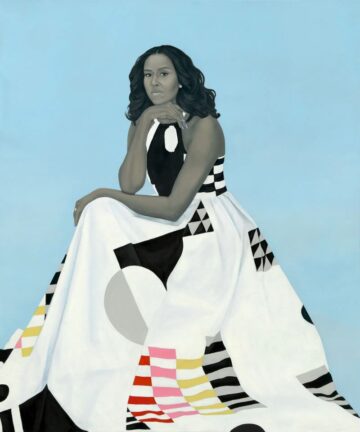
Originally published in The Voice of San Francisco in November 2024
The SFMOMA presents Amy Sherald’s first mid-career survey, American Sublime. This exhibit brings together 50 paintings made from 2007 to the present, including works rarely seen by the public, and some new pieces created specifically for the exhibition.
Paintings as Popular Culture
Paintings rarely become so ubiquitous that they enter the population’s visual vocabulary, but Amy Sherald’s paintings have broken into that rarefied space of popular observance. Unveiled in the National Portrait Gallery in 2018, Sherald’s portrait of First Lady Michele Obama is arguably one of the most recognized paintings made in the U.S. in the last 50 years. She is painted in grisaille, French for “grey” in keeping with the European style of grey monochrome. Her white dress and its geometric design suggests action and movement in contrast with the calm of Obama’s visage, chin poised on her hand, placed before a cool blue background. Sherald used her signature greyscale approach again in her iconic portrait of Breonna Taylor. Shot to death by the police in 2020 after an illegal raid of her apartment, Taylor became a face for the Black Lives Matter movement. In honoring her memory, Sherald recreated Taylor as a strong and regal presence. The artist went so far as to have a fashion designer provide input on the dress design, and included an engagement ring on her finger to symbolize her love for her partner.
American Sublime
American Sublime considers for the first time Sherald’s work within the context of American realist and figurative painting. Sherald’s process – meeting people on the street, inviting them to be photographed then transforming the images in paint– will be revealed in gallery texts and catalogue essays.
The paintings are organized into six thematic galleries. In the opening gallery, paintings were selected that take up particularly American motifs that challenge historical ideas of what it means to be “American.” A centerpiece in this gallery is a painting recently acquired by SFMOMA, For Love, and For Country. The image is a play on the well-known photograph by Alfred Eisenstaedt of a sailor kissing a woman in Times Square in 1945. In Sherald’s 10–foot-tall reimagining of this image, the embrace is happening between two men in a rebuttal of the rising discrimination and restrictive legislation against the LGBTQ+ community. Another nod to American photography is If You Surrendered to the Air, You Could Ride It, takes its inspiration from Charles C. Ebbett’s famous photograph of steel workers taking a break on a construction site high above Manhattan. Sherald’s paintings point out the greatness of American industry and the Black workers whose contributions and advancements have been largely erased from history.
The Precious Futures gallery focuses on the vulnerability and importance of Black children and youth. Imagining a better future is a constant theme in paintings like The Boy with No Past, a picture of what it would be like – will be like – to grow up as a young Black man in America without the country’s omnipresent legacy of racism and violence. The centerpiece of the gallery is called The Girl Next Door-the image of Breonna Taylor – alive with vitality and strength. Michelle Obama’s portrait will be included in an adjacent gallery.
The gallery titled An inside and Outside navigates the world of public versus private personas and the tension between the deliberately private, intimate self and a public self exposed to external preconceptions and norms. The anchor work is Listen, you a wonder. You a city of a woman. You got a geography of your own, a title drawn from Lucille Clifton’s poem “what the mirror said.” A woman with a composed demeanor sits in a wide-brimmed hat, a striking black and white dress, speaking to the changing narrative of Black culture in the U.S. and what it means to be, and to be seen as, American.
An Ode to Everyday People
Sarah Roberts, SFMOMA’s former Andrew W. Mellon Curator and Head of Painting and Sculpture, organized the exhibit and offered this observation regarding Sherald’s legacy of figurative painting. “In the spirit of great American artists like Edward Hopper, Alice Neel and Kerry James Marshall, Sherald’s works reframe our understanding of American culture. Her paintings invite viewers to recognize and move beyond preconceived ideas and engage in more expansive thinking about race, representation and the wide-open possibilities and complexities of every individual.”
Sherald addresses the omission of Black figures from the history of figure painting by showing her characters as a resting place. Her figures are not viewed in contention, not racialized or politicized, they simply are. They exist in space. In this way she has created an ode to everyday people and a convincing testament that, as Sherald believes, images can change the world.